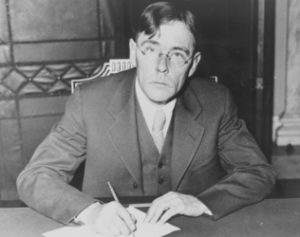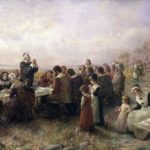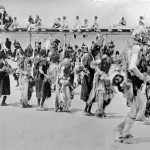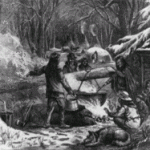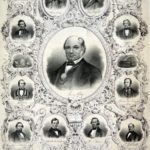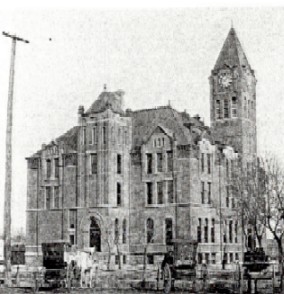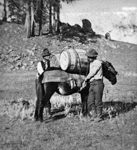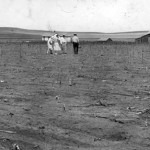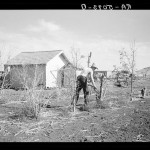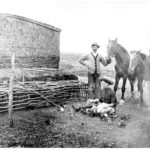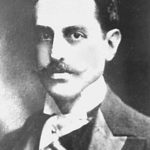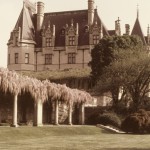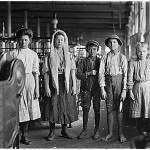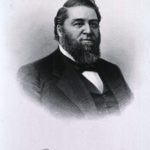Few townspeople liked Dr. Harry Hummer when he first came to Canton, primarily because he was replacing the very popular former superintendent of the Canton Asylum for Insane Indians, Oscar Gifford. However, Hummer eventually began to fit in and the Canton community stood shoulder-to-shoulder with him when the asylum was threatened with closure. Continue reading
Author Archives: Carla Joinson
Thanksgiving
The Thanksgiving holiday does not have the same significance for Native Americans as it does generally for others in this country. The fact that European pilgrims survived their first harsh winter boded ill for native peoples who suffered death, disease, and cultural disintegration at their hands. However, many Native American tribes incorporated gratitude into everyday life, often thanking plants and other living things for giving themselves to human use. Many tribes also had specific times and occasions for which they specifically took time out to express gratitude, such as mid-winter and harvest time.
Among others, the Creek, Cherokee, Seminole, Yuchi, and Iroquois tribes celebrated the Green Corn Festival, which marked the beginning of the first corn harvest. It was a time to thank Mother Earth and all living things for providing food and other usable items that made life good. Most Native Americans had various harvest ceremonies with the same purpose in mind. The Iroquois particularly formalized times of thanksgiving, which would include a special Thanksgiving Address. A speaker was chosen to give thanks on behalf of all the people. The thanksgiving prayer then offered gratitude to the Creator for the earth and the living things upon it. The prayer could be quite long, encompassing specific things the speaker wanted to call special attention to, like birds, rivers, medicinal grasses and herbs, wind, rain, sunshine, the moon and stars, and so on.
For many Native Americans, gratitude intersected with the spirituality they brought to daily life. Ceremonies simply formalized the gratitude they typically expressed on a smaller scale every day.
______________________________________________________________________________________
Always Positive
The Sioux Valley News, Canton’s weekly newspaper, was unrelentingly upbeat about Canton and its prize establishments.
When the Canton Asylum for Insane Indians faced closure after two serious investigations, the newspaper decried all attempts to shut the facility down and rallied to the asylum’s cause. Continue reading
News is Up Close and Personal
Most people in Canton, SD probably knew each other or knew of each other–if they didn’t, it wasn’t because The Sioux Valley News wasn’t keeping them informed. Continue reading
A Lively Town
Citizens of Canton, SD were proud of their town. It offered many goods and services, and supported many civic and social clubs. Canton’s weekly newspaper, The Sioux Valley News, acted as a conduit of information and provides a lively picture of the townspeople’s interests and concerns.
On October 26, 1906, just one page of the newspaper covered the following events:
Canton Is An Important Town in Lincoln County
Some may wonder how Oscar Gifford, the first superintendent at the Canton Asylum for Insane Indians, could make much of a pitch for the little town to host what might have become quite a large and important facility. South Dakota was a fairly centralized part of the country for the Indian population it sought to help, so the asylum’s location in that state was not so surprising. Continue reading
Settlement in Lincoln County
Lincoln County, South Dakota, became an entity in 1862. No white settlers seemed to be permanent residents there, though a rough road cut through a portion of its far upper corner. The first permanent resident arrived in 1866 and built a dugout to live in while he planted his first few acres of hay. Other settlers began to straggle in or arrive in small groups, and quickly set up local governing bodies of commissioners, justices of the peace, and so on. Many of them found the lush Sioux Valley very attractive and rich. Other parts of the area were flat and drab, but all areas had rich soil and promising futures. The cities of Canton (site of the Canton Asylum for Insane Indians), Eden, Worthing, and Lennox sprang up quickly, and other small towns followed the establishment of the railroad.
Many of the early settlers were Norwegian, with Germans following as the second largest ethnic group. Many began their new lives in dugouts and sod homes (see last post) where they faced the severe weather common to the area. They were by necessity a tough group of people who were determined to make it in a strange, new land. However, one problem they had probably never faced before was grasshopper swarms. These pests, arriving in great clouds and eating so vigorously that they reportedly sounded like “thousands of scissors snipping.” The swarms damaged or ruined crops five years in a row during the 1870s and doubtlessly discouraged many of the newcomers or forced some to return home. Despite these struggles, the county population increased from under a hundred in its early days to 6,000 by 1880.
______________________________________________________________________________________
The Other Half
In contrast to the Gilded Age mansions of the Vanderbilts and Rockefellers (see last post), most American families lived in considerably humbler abodes during the late nineteenth century. Families striving to create a new life in western lands often lived primitively, creating a first home out of whatever materials came to hand. Because trees were scarce, sod homes were common in the prairie states. It was far more important to build by a stream or within the shelter of a hill than to strive for a certain architectural style or type of building material.
Sod homes were difficult to build, but they were cheap and a definite step up from the dugouts that many families stayed in when they first settled. Dugouts were merely holes in the side of a hill which families quickly excavated in order to get out of their tents and covered wagons. Many times, they built their sod home in front of the original dugout and kept using the dugout as a room. Sod homes could be cozy and warm, and because they were built of dirt, fireproof. However, snakes, mice, and insects could find their way in, and often did. Dirt was a constant problem, and earth sometimes dropped in chunks from the ceiling or trickled down in a muddy drizzle during rainy weather. The roof itself might collapse during heavy rains, while underfoot, the floor turned to mud. Women could be constantly exasperated by the drawbacks of sod homes, and many wished for the relative comforts they had left behind in the East.
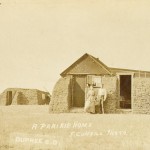
Prairie Home in Dupree, SD, courtesy Special Collections and University Archives, Wichita State University
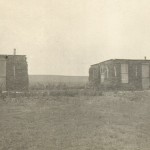
Early Homes for Settlers in SD, courtesy Special Collections and University Archives, Wichita State University
______________________________________________________________________________________
Extremes in America
Just like today, the U.S. population experienced extremes of wealth and living standards in the late 1800s. The 175,000 square foot Biltmore Estate, still the largest privately-owned home in America, was built between 1888 and 1895. George Vanderbilt equipped his new home with modern innovations like running water in the bathrooms, electricity (it was wired for both A/C and D/C because standards hadn’t been decided on), and refrigeration for the kitchen. The home had 250 rooms, of which 35 were bedrooms and 43 bathrooms. In its heyday, there were 30-35 servants to wait on the family and guests.
Built toward the end of the Gilded Age (late 1860s until nearly 1900), Biltmore represented the kind of lifestyle available to wealthy families during an era without income taxes or much industrial regulation. (A permanent income tax became law in 1913.) Men like Andrew Carnegie J. P. Morgan, and John D. Rockefeller amassed dazzling fortunes in often ruthless ways; Rockefeller was the first American to amass $1 billion in personal wealth. In contrast, most families in America earned less than $1,200 annually, and many well below $500. The president of the United States earned $50,000 per year.
______________________________________________________________________________________
No Exemption From Danger
Though attendants and nurses bore the brunt of patient violence (see last post), no one on staff at an insane asylum was truly immune. On March 16, 1882, the superintendent of Utica Insane Asylum, John P. Gray, sat in his office with two staff members and his son. Henry Remshaw, who had made threats against the doctor several weeks before the shooting, walked in and shot Gray through the upper jaw. Continue reading
